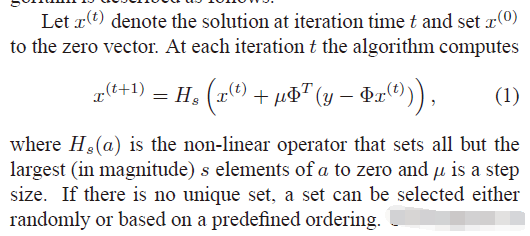压缩感知重构算法之OMP算法python实现
压缩感知重构算法之CoSaMP算法python实现
压缩感知重构算法之SP算法python实现
压缩感知重构算法之IHT算法python实现
压缩感知重构算法之OLS算法python实现
压缩感知重构算法之IRLS算法python实现
IHT(iterative hard thresholding )算法是压缩感知中一种非常重要的贪婪算法,它具有算法简单的有点,且易于实现,在实际中应用较多。本文给出了IHT算法的python和matlab代码(本文给出的代码未经过优化,所以重建质量不是非常好),以及完整的仿真过程。
算法流程
python代码
要利用python实现,电脑必须安装以下程序
- python (本文用的python版本为3.5.1)
- numpy python包(本文用的版本为1.10.4)
- scipy python包(本文用的版本为0.17.0)
- pillow python包(本文用的版本为3.1.1)
#coding:utf-8
#%%%%%%%%%%%%%%%%%%%%%%%%%%%%%%%%%%%%%%%%%%%%%%%%%%%%%%%%%
# DCT基作为稀疏基,重建算法为IHT算法,图像按列进行处理
# 参考文献: Carrillo R E, Polania L F, Barner K E. Iterative hard thresholding for compressed sensing
#with partially known support[C]
#//Acoustics, Speech and Signal Processing (ICASSP),
#2011 IEEE International Conference on. IEEE, 2011: 4028-4031.
#
#%%%%%%%%%%%%%%%%%%%%%%%%%%%%%%%%%%%%%%%%%%%%%%%%%%%%%%%%%
#导入集成库
import math
# 导入所需的第三方库文件
import numpy as np #对应numpy包
from PIL import Image #对应pillow包
#读取图像,并变成numpy类型的 array
im = np.array(Image.open('lena.bmp'))#图片大小256*256
#生成高斯随机测量矩阵
sampleRate=0.7 #采样率
Phi=np.random.randn(256,256)
u, s, vh = np.linalg.svd(Phi)
Phi = u[:256*sampleRate,] #将测量矩阵正交化
#生成稀疏基DCT矩阵
mat_dct_1d=np.zeros((256,256))
v=range(256)
for k in range(0,256):
dct_1d=np.cos(np.dot(v,k*math.pi/256))
if k>0:
dct_1d=dct_1d-np.mean(dct_1d)
mat_dct_1d[:,k]=dct_1d/np.linalg.norm(dct_1d)
#随机测量
img_cs_1d=np.dot(Phi,im)
#IHT算法函数
def cs_IHT(y,D):
K=math.floor(y.shape[0]/3) #稀疏度
result_temp=np.zeros((256)) #初始化重建信号
u=0.5 #影响因子
result=result_temp
for j in range(K): #迭代次数
x_increase=np.dot(D.T,(y-np.dot(D,result_temp))) #x=D*(y-D*y0)
result=result_temp+np.dot(x_increase,u) # x(t+1)=x(t)+D*(y-D*y0)
temp=np.fabs(result)
pos=temp.argsort()
pos=pos[::-1]#反向,得到前面L个大的位置
result[pos[K:]]=0
result_temp=result
return result
#重建
sparse_rec_1d=np.zeros((256,256)) # 初始化稀疏系数矩阵
Theta_1d=np.dot(Phi,mat_dct_1d) #测量矩阵乘上基矩阵
for i in range(256):
print('正在重建第',i,'列。。。')
column_rec=cs_IHT(img_cs_1d[:,i],Theta_1d) #利用IHT算法计算稀疏系数
sparse_rec_1d[:,i]=column_rec;
img_rec=np.dot(mat_dct_1d,sparse_rec_1d) #稀疏系数乘上基矩阵
#显示重建后的图片
image2=Image.fromarray(img_rec)
image2.show()
matlab代码
%代码在matlab2010b测试通过
function Demo_CS_IHT()
%%%%%%%%%%%%%%%%%%%%%%%%%%%%%%%%%%%%%%%%%%%%%%%%%%%%%%%%%%%%%%%%%%%%%%%%%%%
% the DCT basis is selected as the sparse representation dictionary
% instead of seting the whole image as a vector, I process the image in the
% fashion of column-by-column, so as to reduce the complexity.
% Author: Chengfu Huo, roy@mail.ustc.edu.cn, http://home.ustc.edu.cn/~roy
% Reference: T. Blumensath and M. Davies, “Iterative Hard Thresholding for
% Compressed Sensing,” 2008.
%%%%%%%%%%%%%%%%%%%%%%%%%%%%%%%%%%%%%%%%%%%%%%%%%%%%%%%%%%%%%%%%%%%%%%%%%%%
%------------ read in the image --------------
img=imread('lena.bmp'); % 256*256大小
img=double(img);
[height,width]=size(img);
sampleRate=0.7; %采样率
%------------ form the measurement matrix and base matrix ---------------
%Phi=randn(floor(height/3),width); % only keep one third of the original data
%Phi = Phi./repmat(sqrt(sum(Phi.^2,1)),[floor(height/3),1]); % normalize each column
Phi = orth(rand(256, 256));
Phi=Phi(1:256*sampleRate, :);
mat_dct_1d=zeros(256,256); % building the DCT basis (corresponding to each column)
for k=0:1:255
dct_1d=cos([0:1:255]'*k*pi/256);
if k>0
dct_1d=dct_1d-mean(dct_1d);
end;
mat_dct_1d(:,k+1)=dct_1d/norm(dct_1d);
end
%--------- projection ---------
img_cs_1d=Phi*img; % treat each column as a independent signal
%-------- recover using omp ------------
sparse_rec_1d=zeros(height,width);
Theta_1d=Phi*mat_dct_1d;
for i=1:width
column_rec=cs_iht(img_cs_1d(:,i),Theta_1d,height);
sparse_rec_1d(:,i)=column_rec'; % sparse representation
end
img_rec_1d=mat_dct_1d*sparse_rec_1d; % inverse transform
%------------ show the results --------------------
figure(1)
subplot(2,2,1),imagesc(img),title('original image')
subplot(2,2,2),imagesc(Phi),title('measurement mat')
subplot(2,2,3),imagesc(mat_dct_1d),title('1d dct mat')
psnr = 20*log10(255/sqrt(mean((img(:)-img_rec_1d(:)).^2)));
subplot(2,2,4),imshow(uint8(img_rec_1d));
title(strcat('PSNR=',num2str(psnr),'dB'));
disp('over')
%************************************************************************%
function hat_x=cs_iht(y,T_Mat,m)
% y=T_Mat*x, T_Mat is n-by-m
% y - measurements
% T_Mat - combination of random matrix and sparse representation basis
% m - size of the original signal
% the sparsity is length(y)/4
hat_x_tp=zeros(m,1); % initialization with the size of original
s=floor(length(y)/4); % sparsity
u=0.5; % impact factor
% T_Mat=T_Mat/sqrt(sum(sum(T_Mat.^2))); % normalizae the whole matrix
for times=1:s
x_increase=T_Mat'*(y-T_Mat*hat_x_tp);
hat_x=hat_x_tp+u*x_increase;
[val,pos]=sort((hat_x),'descend'); % why? worse performance with abs()
hat_x(pos(s+1:end))=0; % thresholding, keeping the larges s elements
hat_x_tp=hat_x; % update
end
参考文章
1、Carrillo R E, Polania L F, Barner K E. Iterative hard thresholding for compressed sensing with partially known support[C]//Acoustics, Speech and Signal Processing (ICASSP), 2011 IEEE International Conference on. IEEE, 2011: 4028-4031.
欢迎python爱好者加入:学习交流群 667279387























 1434
1434

 被折叠的 条评论
为什么被折叠?
被折叠的 条评论
为什么被折叠?








